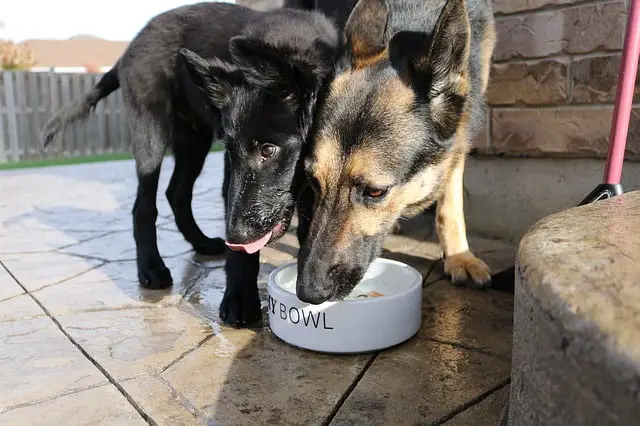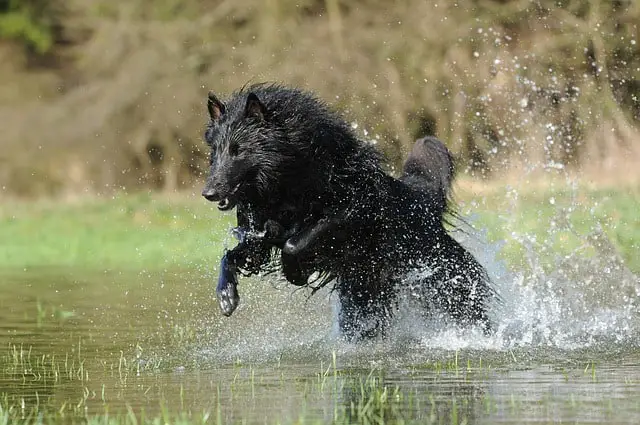Belgian shepherd dogs are actually a group of four different herding dogs that at one time were grouped together as one breed but today comprise four separate breeds in most countries.
They are the Groenendael, or Belgian sheepdog, the Malinois, Laekenois, and the Tervuren.
The Belgian shepherds were all originally bred for herding and have been used by the military in both WWI and WWII.
Today, they can still be found in the military, working as police dogs, used for herding, for search and rescue, as guide dogs and service dogs as well as in the family unit as a beloved pets.
In this post, information will be provided with Belgian shepherd facts, but we will concentrate mainly on the Belgian Groenendael, also known as the Belgian sheepdog.
All of these “shepherds” and “sheepdogs” can be confusing, so read on for a better understanding.

For your dog’s vitamin supplement, foods, toys, or other dogs product please visit the Health Extension website.
What Is a Belgian Shepherd?
The Belgians Groenendael, Malinois, Laekenois, and Tervuren are all breeds of Belgian Shepherds, but the Belgian Groenendael is quite often referred to as the Belgian sheepdog.
They were all considered a separate breed at one time however some countries still do lump them all into the shepherd category.
This can be a bit confusing and also call the Groenendael a shepherd and a sheepdog. Whatever the name, the Groenendael is by far the most well-known and favorite of the four.
History of the Belgian Groenendael
Although the Belgian Groenendael is quite a mouthful and probably hasn’t rung a bell with you, I will be referring to the breed also as a Belgian sheepdog too. They are also called “Chien de Berger Belge.” Talk about a mouthful!
The Belgian Groenendael was developed during the 1800s in Belgium, specifically for herding cattle.
The sheepdog has a mixture of the German shepherd, Dutch shepherd, Briard, and Bouvier des Ardennes all rolled into this spectacular breed.
They also acquired their name, Groenendael from the kennel at which they were created.
During WWI, the Belgian Army used Belgian sheepdogs to relay messages and to search out wounded soldiers.
The American soldiers were so impressed, they had the Groenendael imported, although today in the United States they are called the Belgian sheepdog.
Today, the American Kennel Club recognizes all four dogs as separate breeds. A few national kennel clubs still consider the Belgian shepherd one breed with four different varieties.
The Groenendael is used today for herding, working with the military and police, for search and rescue, as an assistant and guide dog, for competition and show, and also as a loving and loyal family companion.
To check your Belgian Shepherd’s health status or their DNA, please visit the Embark vet website for all the help you may need.

Belgian Groenendael Appearance
All four of Belgian shepherds are somewhat anatomically similar, but each breed has a very different fur coat.
According to the American Kennel Club, the Belgian Groenendael lifespan of the Belgian Groenendael ranges from twelve to fourteen years.
The Belgian Groenendael male is between 24 inches and 26 inches in height and the female is between 22 inches to 24 inches in height.
The Belgian Groenendael male weighs between 55 pounds and 75 pounds, and the female weighs between 45 pounds and 60 pounds Pound.
The Groenendael has a muscular, agile, and strong body and is of medium size with pointed ears, almond-shaped brown eyes, a pointy muzzle, and a bushy tail.
They do facially resemble a German shepherd, but only have black fur, sometimes with subtle white markings on the face, chest, fronts of toes, or between paw pads.
Mostly pure black, they have a long, straight, thick, luxurious coat. Short hair is apparent on their head.
They do have a double-thick coat like most shepherds, that has an undercoat for warmth and insulation and is also waterproof, allowing them to work outdoors in the best and worst of the elements.
The Belgian Sheepdog’s coat can be a challenge in the maintenance department. There will be quite a bit of shedding and more so twice a year during shedding season when they lose their entire undercoat.
Brushing about two times a week to remove tangles, prevent mats and get rid of loose dead fur should be sufficient.
Belgian Groenendael Temperament
The Belgian Groenendael is a powerhouse of a dog in every aspect of personality and temperament. They are:
- Brave
- Loving
- Loyal
- Extremely hard-working
- Intelligent
- Highly trainable
- Obedient
These wonderful attributes of the Belgian sheepdog are a plus, but this breed, like all dogs, needs plenty of socialization as a puppy to become well-rounded and well-behaved. They need to become acclimated to all kinds of people, dogs, and situations.
The Belgian Groenendael is instinctively a herding and guarding dog. They will ultimately want to protect you and your family and your territory or home.
This breed is not a happy-go-lucky friend to all like the attention-loving golden retriever. They do need to carefully assess strangers that come to your home until they are satisfied there is no threat. Proper socialization may not totally remove this instinct but will soften it.
The Belgian Groenendael, as a herder, will always be a herder and you will never totally remove this reaction from them.
They may try to herd children or your family and this may involve some nipping at heels and barking. Training will help them learn that this is unacceptable behavior in the family unit.
Because they have high energy, the Belgian sheepdog requires a lot of exercise. They are best suited to an active family that spends time outdoors. This is not a couch potato family dog.
The Belgian Groenendael does have a prey drive that is high, so they generally don’t do well in homes with smaller pets such as cats, hamsters, guinea pigs, etc.
If you are raising a Groenendael puppy along with a small pet, this may be a different story as they grow up together.
They also make great playmates for children, but again, raising a puppy along with toddlers together would be the ideal situation.
The Belgian Groenendael is also accustomed to hard work, so keeping them busy and occupied, so boredom doesn’t set in can be a challenge.
Plenty of exercise, as well as games for mental stimulation, will fill the bill and if you’re into agility or competition, this is great for bonding, additional training, and for those with a competitive nature.
Even though the Belgian Groenendael is a worker and has used their own smarts to work and herd independently, they do crave the companionship of their people. They love to be right in the mix of all family endeavors.

The health of the Belgian Groenendael
All dogs need wellness check-ups and immunizations to keep them healthy, prevent illness, and diagnose any issues that crop up early so they can be attended to.
The best thing you can do if you are considering getting a Belgian Groenendael is research a reputable breeder that participates in genetically testing their breeding dogs.
This can somewhat ensure a healthy dog that does not carry any passed down genes that cause conditions or diseases to develop.
Buying any breed of dog at a pet store can be the very worst choice and like playing Russian roulette.
The Belgian sheepdog is basically a very healthy breed. They should be groomed regularly, checking for any skin issues or parasites as you proceed.
Their ears should be cleaned and checked and their teeth should be brushed. Lack of dental hygiene can cause far more than cavities, as gum disease can develop which can, in turn, cause many health conditions, even affecting the heart.
A few health issues that Belgian Groenendaels can be prone to, with some being inherited are hip and elbow dysplasia, some types of cancers, epilepsy, and eye conditions like cataracts and PRA.
All Belgian shepherds can be sensitive to anesthesia if they require surgery, so it’s good to make sure your veterinarian is informed of that issue beforehand.
If you are considering getting a Belgian Groenendael, hopefully, the Belgian shepherd facts above have given you “food for thought.”
The Belgian sheepdog can be a lot of dog to the inexperienced owner, but there is plenty of help available for training, online, with classes, or using the services of a professional trainer, so don’t hesitate to check it out.
A well-trained, obedient but well-rounded Groenendael can be a wonderful companion for life.
